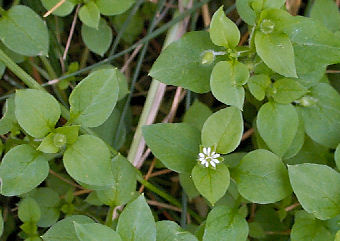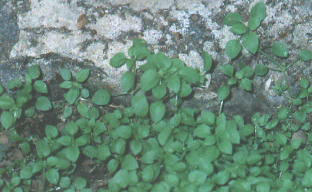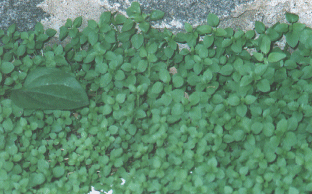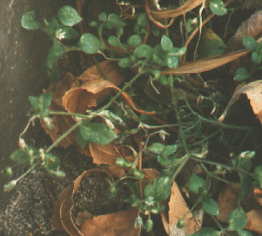|
|
 |

Chickweed is another plant of Eurasian origin that's made itself quite at home in the States and everywhere else that European people have traveled. It is now a common weed almost world-wide. Chickweed is an annual, but is somewhat unusual in that it often germinates in the fall (though it also germinates year-round), and hangs on through the winter, flowering and setting seed in the early spring, and dying off by summer. It's at its best in the spring and fall, as it greatly prefers cool and damp conditions, and will not survive where it's dry and hot. This is a plant I looked everywhere for, and finally found in growing in embarrassing profusion along the north side of my house. Of course, now I see it all over. In spring and fall, before other plants get started, or after they've died or gone dormant, it grows right out in the open, and will generally appear in any sunny area of bare, moist, rich, soil. In summer, it's more at home in cooler, partly shaded places, often provided by other plants. I find it most frequently in gardens, flower beds, and lawns. |

Chickweed has shallow, fibrous, fragile roots. It's easy to uproot accidentally, but will quickly recover if put back. The plant's weak stems mostly trail along the ground (for up to about sixteen inches), but the growing ends may be upright (up to eight inches high). The stems branch very frequently and take root at the leaf junctions. If you look very closely at the stems, you'll see a single line of hairs running up the side, and you'll notice that the line changes sides at each leaf junction. The leaves are opposite, smooth, and oval (with a point at the tip), and the older leaves are stalked, while the new leaves are not. Chickweed is just about always flowering, except in the dead of winter. It has tiny white flowers, about a quarter inch in diameter, in the leaf axils or in terminal clusters, with five deeply notched petals that look like ten, and five green sepals that are longer than the petals. The flowers close at night and open in the morning. They also close when it's about to rain. Possibly they respond to changes in air pressure. It does seem that the flowers don't open at all when a low pressure system is lingering. Chickweed also reacts to nightfall by folding its leaves over the growing tip to protect it. |

The flowers develop into small capsule-like fruits which contain many tiny seeds (up to 15,000 per plant). The seeds generally germinate within a few years, but can remain viable for much longer. Chickweed is generally used as food. I often nibble on it when I'm out in the yard. It has a mild, refreshing flavor. The leaves and stems can be added to salads, cooked as greens, or added to anything you might add greens to (which, to me, is just about everything). Just don't cook it for more than a few minutes. Chickweed is particularly high in ascorbic acid (vitamin C) and mucilage, and also provides rutin, para amino benzoic acid (PABA), gamma linolenic acid (GLA, an omega-6 fatty acid derivative), niacin, riboflavin (B2), thiamin (B1), beta carotene (A), magnesium, iron, calcium, potassium, zinc, phosphorus, manganese, sodium, selenium, and silicon. The seeds are also edible. The plant can be dried for storage. Chickweed is a fairly safe food, however, as almost everything is somehow toxic if you use enough of it, over-consumption of this plant may give you diarrhea. Medicinally, chickweed is tonic, diuretic, demulcent, expectorant, and mildly laxative. It's often recommended for asthma, bronchitis, or congestion. It's also said to help control obesity and is an ingredient in some herbal weight loss preparations. Externally, chickweed relieves itching and inflammation and is generally soothing and moisturizing. It can be used for any minor skin infections or irritations, and is an ingredient in a number of commercial skin care products. As far as I've been able to discover, this common plant has yet to be thoroughly scientifically studied. However, the benefits ascribed to chickweed may simply be the result of its high nutritional value, especially the presence of gamma-linolenic acid (GLA). The medicinal effects of this fatty acid read much like the values ascribed to chickweed. GLA is recommended for a variety of skin problems, for hormone imbalances as in PMS, and for arthritis. It clears congestion, controls obesity, reduces inflammation, reduces water retention, acts as tonic for the liver, and reduces the negative effects of alcohol abuse. Chickens and many other birds love chickweed, and eat both the plants and the seeds, which is how it gets its name. If you keep birds as pets, you can feed it to them too. Chickweed is also one of the primary targets of various broad-leaf herbicides, but as I feel rather strongly about contributing poisons to the ecosystem, I would recommend weeding instead for those people who can't learn to like this useful little plant.
Selected References
|
|
| Home | About this site | Asides/Glossary | Store |
| Taxonomy Tree | Species list | Article list | |
|
Featured sponsors:
|
Mountain Rose Herbs Bulk herbs, teas, oils, & much more! |
Richter's Herbs Seeds & plants |
|
|
© 1999-2015 by Deb Schwartz. All rights reserved. Please send feedback to: deb@kingdomplantae.net Website by ki-yi.com
|
|||